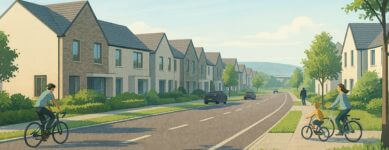Building greener homes isn’t just good for the planet—it’s fast becoming a baseline expectation for investors, planners and homeowners alike. This article explains the key terms and certification schemes behind sustainability in construction, showing how Castlethorn applies them across our Irish residential developments.
Why Sustainability Matters in Irish Housing
Ireland’s Climate Action Plan commits the built environment to a 51% reduction in emissions by 2030—a target that encourages residential developers to deliver energy-efficient, low-carbon homes. Aligning with these goals is now integral to planning approval, ESG reporting, and mortgage affordability for buyers.
Defining Sustainable Construction
Sustainable construction refers to the design, build and operation of homes that minimise environmental impact through every life-cycle stage—materials, construction, in-use energy and end-of-life reuse.
Key pillars:
- Whole-life carbon – embodied + operational emissions
- Resource efficiency – responsibly sourced timber, low-waste MMC
- Health & wellbeing – daylighting, air-quality, community green space
- Economic resilience – lower running costs, higher long-term value
Irish Certifications & Standards to Know
The following four schemes appear on almost every new-build project in Ireland and signal both performance and future cost certainty.
Building Energy Rating (BER)
A BER is a mandatory label that grades operational efficiency from A1 (≤ 25 kWh/m²/yr) to G. An A-rated home not only lowers utility bills but also attracts preferential “green-mortgage” rates from most lenders.
Nearly Zero-Energy Buildings (NZEB)
The legal construction standard since 2021 requires walls, roofs and glazing that are roughly 20 percent more thermally efficient than 2011 rules—helping new stock remain “future-proof” against energy-price volatility.
Home Performance Index (HPI)
Developed by the Irish Green Building Council, HPI combines energy, water, ecology and indoor-air metrics. A high score can strengthen Help-to-Buy green-mortgage applications and add long-term asset value.
SEAI Retrofit Grants
While aimed at existing homes, grant schemes for heat pumps, solar PV and deep-fabric upgrades give buyers clear pathways for any future improvements.
→ Further reading: See What is a BER? and Irish Planning Laws Explained guides.
International Frameworks Investors Ask About
Global capital often benchmarks Irish assets against these familiar rating systems; understanding them helps you compare like-for-like and unlock green finance.
- BREEAM (UK origin): Widely used for fund-level ESG reporting on purpose-built rental blocks; its credit system overlaps with BER/NZEB requirements, and Castlethorn targets “Very Good” as a minimum on multifamily schemes.
- LEED (US origin): Favoured by international portfolios; its Energy & Atmosphere credits map closely to Ireland’s Part L regulations, making cross-border comparisons easier.
- EU Taxonomy for sustainable activities: A classification that defines what counts as a “sustainable investment.” A-rated, NZEB-compliant homes qualify as a “Substantial Contribution to Climate Mitigation,” broadening access to green-bond markets.
Castlethorn in Practice
Castlethorn’s approach blends a fabric-first philosophy with modern methods of construction to drive down energy use and environmental impact. Across recent projects we deploy high-performance insulation and airtight membranes that cut heat loss by around 60 percent compared with 2005 regulations, while mechanical demand-controlled ventilation keeps indoor air healthy without adding to energy bills.
As an example, the Woodbrook Cost-Rental (with LDA) includes 328 apartments pre-engineered for solar-PV arrays; designed to exceed NZEB by 10% and meet BREEAM Very Good on communal areas.
Benefits for Buyers & Investors
Sustainability credentials deliver measurable advantages across every stakeholder group:
Homebuyers enjoy lower annual energy bills—A-rated homes can save roughly €800–€1,200 compared with a C-rated equivalent—and healthier indoor air thanks to high-performance ventilation.
Investors & Funds gain assets that align with the EU Taxonomy, opening doors to green-debt instruments while reducing future retrofit risk as regulations tighten.
Communities benefit from a smaller collective carbon footprint and long-term social value through shared green spaces, local amenities and resilient infrastructure.
Implications & Next Steps
Due-diligence checklist:
- Ask for whole-life-carbon figures alongside BER.
- Verify third-party certifications (HPI, BREEAM) at planning-grant stage.
- Review renewable-energy provision (PV, heat pumps) and associated maintenance warranties.
- Confirm EU-Taxonomy alignment if seeking green financing.
Final Thoughts
Sustainability in construction is no longer optional. By adopting fabric-first design, MMC and internationally recognised certifications, Castlethorn ensures every new community is resilient, efficient and finance-ready—today and for decades to come. Contact us today to learn more!




